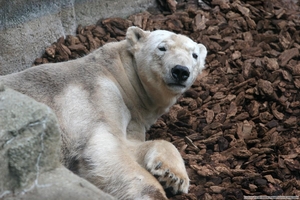When most people hear the phrase ‘global climate change,’ they think of glaciers melting and ocean levels rising enough to cover the entire Florida peninsula. Because it is believed that most recent climate changes have been driven by man-made causes, climate change has unfortunately become a political issue. Now many people view climate change as if it were Santa Clause, either choosing to believe or not believe.
The fact is that surface temperatures on the earth have increased in recent years at a rate unprecedented in geologic time; and this rate of warming does not appear to be slowing, but in fact increasing. Whether or not these changes represent a permanent shift, or simply are part of natural fluctuations that can occur over geologic time is what most intelligent debates likely center around.
Many are familiar with side effects of global warming with regards to weather changes. Patterns of rainfall and drought will become more erratic and fluctuate more severely. There will be more catastrophic weather events, such as hurricanes and typhoons. But what do all these effects have on plants and animals?
Shifting range boundaries:
Many of the changes that will occur will be due to shifting range boundaries. Each species has a range of climatic variation it can tolerate. As cool climates move increasingly north, species that thrive in cool temperatures will also move north. If these species are not able to move or adapt to their new environment, the species can become extinct. At the poles, where sea-ice is becoming less common and more fragmented and northward movement is not possible, polar bears have suffered significant population declines and are less healthy than in previous decades.
This shift in cooler temperatures also occurs on an elevational gradient. As the earth warms, the cool air found on mountaintops will gradually get higher and higher on that mountain. Species will have to shift upwards in elevation in this case.
When species shift boundaries, whether north to south, or low to high they begin to encounter stressors (such as predators, competitors, and diseases) they did not encounter in their old habitat. If they are incapable of adapting to these new stressors, extinction may occur in part or all of a species’ range.
Changes in phenology:
The timing of a species’ breeding or migration (etc.) is known as a phenological response. Shifts in the earth’s temperature can alter species’ phenology. For instance, in Ithaca, New York a 10 to 13 day advance has been recorded in the breeding of six frog species over the past 100 years. Such advancements in butterfly and bird migrations have also been noted.
These seemingly small changes in timing of critical functions can have great impacts on these species. The presence of pollinators may no longer coincide with plant flowering. Frogs may emerge from hibernation before spring ponds fill with sufficient water to maintain eggs and tadpoles. A study in Colorado shows that yellow-bellied marmots emerge from hibernation 23 days earlier than 30 years ago, but their favorite food plants still emerge later.
Invasive species:
Some species are very adaptable and can handle a wide range of climates. Many others cannot. The rate of global climate change at this time is greater than the amount of time it would take for many of these more sensitive species evolve to the climatic changes. What this will eventually lead to is extinction of the sensitive species and the increasing presence of species that are broader ranging. Generally these are known as pest species, and are undesirable (examples include kudzu, bullfrogs, cattails, and zebra mussels).
Whether or not you are a “believer” in global warming, changes observed in plant and animal life worldwide are all biased in the direction of increasing global temperatures. These changes are occurring too quickly for most plant and animal life to adapt, so our world is risking extinction of multiple species if global temperatures continue to rise.





